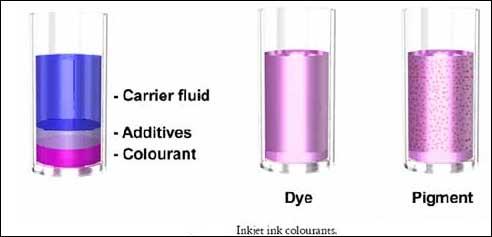Home Profile
Profile  Product Range
Product Range Industries
Industries Infrastructure
Infrastructure Our Quality
Our Quality Custom Manufacturing
Custom Manufacturing Network
Network Contact Us
Contact Us Send Enquiry
Send Enquiry



Colorants for Printing Inks
We all use inkjet inks in our printers of various hues and
application. The most vital part of the inkjet printer is the ink that we
use in the cartridge. In fact the determinants of the quality of printing
are the type, quality, and the quantity of ink in the cartridge. Inkjet inks
are classified into the following four types of categories:
- Water based
- Oil-based
- Solvent-based
- Curing
- Hybrid ink
Buying Tips
Obey the rules- First and foremost is to
obey the printer manufacturer's advices.
Watch out for compatibility- The association of ink and paper is a
complex one and difficult to optimize. It has been often seen that
bargain-priced inks or papers leads to results that is not upto the mark.
Working ink-paper pairs- Normally the following combination has been
seen to work better:
- Dye/ colorant + coated paper
- Pigment + nanoporous paper
Smart Choice between pigments and dyes- Remember the choice you make
is some sort of a delicate balance between quality of the color and the
factor of longevity. Dyes are the way to go if your criteria is good life
and and color.
See the color gamut comparison charts in proper perspective- Do not
hesitate to ask for direct comparison prints on exactly the type of media
that you would be using.
Water based inkjet inks
Water based inkjet inks are very common inks that are
used for printing. They are generally used for application in paper.
Basically, the water or aqueous ink formulations comprises mainly of a
carrier fluid that is able to keep the liquid in a liquid state thus acting
as a sort of carrier for the fluid. They do not contain any volatile organic
compounds in them and has a very low level of toxicity.
Water-based inkjet inks as a product can be broadly classified into two
general categories:
- Dyes for Water Based Inkjet Inks
- Pigments for Water Based Inkjet Inks
The diagram given below illustrates both the type:-

This diagram makes clear that dyes get fully dissolved in the carrier fluid
whereas pigments are fine powders of solid colorants and get dispersed in
the color fluid.
To understand the role of dyes and pigments in Water based inkjet inks,
first there is a need to look at the basic ingredients of a water based
inkjet inks.
| Ink component |
Use |
wt-% |
| Colorant |
It gives the ink it's basic function - absorbing of light of the
specific wave length band |
2-8 |
| Carrier fluid |
Suspends or helps in dissolving the colorant |
35-80 |
| Surfactant |
Helps to promote wetting by lowering the surface tension |
0.1-2.0 |
| Humectant |
Helps in inhibiting evaporation(mixes with the carrier fluid) |
10-30 |
| Penetrant |
Helps to penetrate ink in the paper surface |
1-5 |
| Dye solubilizer |
Helps to promote dye solubility in the carrier fluid |
2-5 |
| Anticockle additive |
Checks interaction with paper fibres that can very well lead to
paper cockle |
20-50 |
Pigment or Dye: The Great Debate
There has been a great debate regarding which medium
is better whether dyes or pigments. Though there is no conclusive evidence
regarding the superiority, but both Dyes and Pigment-based inks have their
plus and minuses. While water based inkjet inks using dyes has been a
traditionally favoured process. But with changing times pigment based inks
are getting increasingly accepted as a choice. The following sections give
some comparisons between the two:
| Dye Based Ink |
Pigment Based Ink |
Pluses
- Soluble and stable
- Vast color pallete
- Enormous range
- Bright and intense color
- Dyes are far efficient in Graphic printing
- Larger color pallete
- Bright and vibrant colors
|
Pluses
- Water fastness shows marked improvement
- Improved light fastness
- Distinct improvement in Archivability
- Clarity of Print
- Pigments good in Outdoor Application
|
Minuses
- Shows tendency for fading
- Shows limited resistance to water
- Nozzle crusting
|
Minuses
- Range limited
- Tendency to clog
- Expensive
- Colors not that vibrant and bright
|
| Latest Trend: Manufactures are now opting for combination inks with
improved light and water fastness but not at the cost of color
intensity. |
|
Home Profile
Profile
 Product
Range
Product
Range Industries
Industries Infrastructure
Infrastructure Our
Quality
Our
Quality Custom
Manufacturing
Custom
Manufacturing Network
Network Contact
Us
Contact
Us Send
Enquiry
Send
Enquiry

![]() Profile
Profile ![]() Product Range
Product Range![]() Industries
Industries![]() Infrastructure
Infrastructure![]() Our Quality
Our Quality![]() Custom Manufacturing
Custom Manufacturing![]() Network
Network![]() Contact Us
Contact Us![]() Send Enquiry
Send Enquiry



![]() Profile
Profile
![]() Product
Range
Product
Range![]() Industries
Industries![]() Infrastructure
Infrastructure![]() Our
Quality
Our
Quality![]() Custom
Manufacturing
Custom
Manufacturing![]() Network
Network![]() Contact
Us
Contact
Us![]() Send
Enquiry
Send
Enquiry